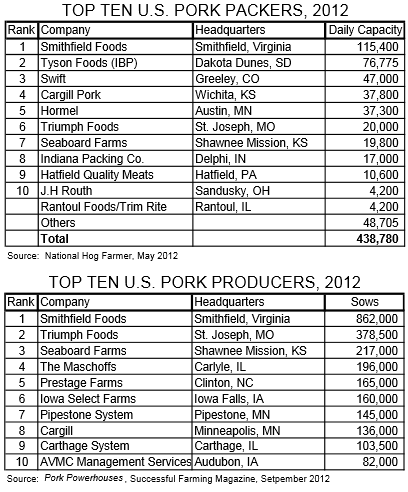



CME: Pork Merger Expected to Enhance US Exports to China
US - The announcement that Smithfield Foods has been purchased by China’s largest publicly-traded meat processor was all the buzz in the livestock/meat sector - and rightfully so, write Steve Meyer and Len Steiner.This is a major purchase by a company from a country that some expect to eventually become our largest pork export customer. Remember the “China Principle”: 1.3 billion times any number is a very big number!
First, the specifics of the deal. China’s Shuanghui Holdings, Ltd., parent company of Henan Shuanghui, the Chinese meat processing firm, is buying Smithfield for $34 per share. That is a premium of about 30 per cent to the stock’s recent value and puts the transaction price at $4.7 billion in cash. According to a report from National Public Radio, it also values Smithfield at $7.1 billion. Several sources reported that that value makes this the largest Chinese purchase of a US company to date.
Second, it appears that Shuanghui intends to leave Smithfield’s management in place and has no plans to make changes in Smithfield’s operations. Smithfield CEO Larry Pope said that the company would not close any facilities and will leave all employee agreements in place.
Third, let’s keep this in perspective. While Smithfield is a behemoth both as a packer and hog producer, it is a drop in the bucket compared to hog numbers, pork production and pork consumption in China. The following tables show Smithfield’s importance in the US industry. It has roughly a 26 per cent share of US hog slaughter capacity and a 16 per cent share of the US sow herd. (Note that the Successful Farming numbers are sows only so we assumed that 10 per cent of the June 1 US “kept for breeding” number was comprised of replacement gilts and boars in arriving at that 16 per cent figure.) But where 862,000 sows will produce somewhere in the vicinity of 20 to 22 million market hogs per year, China in 2012 had 49.28 million sows and slaughtered 694 million hogs. Smithfield’s US numbers would account for 1.7 per cent of the Chinese sow herd and three per cent of China’s 2012 slaughter.

So what are the implications of this purchase for the US pork industry? The purchase does not change the structure of the US industry at all and thus should have no impact on the competitive landscape. In spite of the predictable outcry by small farm advocates and even some US lawmakers, the purchase does not change concentration levels or remove any competitors from the US market-place. There is no reason that US antitrust laws should come into play in any review of the transaction. The sale is subject to review by the Committee on Foreign Investment in the United States (CFIUS) but we understand that that group’s major focus is on national security issues and we do not see that this one poses any such threats.
Does this potentially transfer US technology to China? Smithfield may have some unique systems or procedures but we doubt that there is much, if any, technology in Smithfield’s plants or hog farms that Chinese firms could not access already. US firms have been actively working with Chinese companies for years and, again, raising and processing pigs probably doesn’t involve much spying or missile technology.
We suspect that the merger will enhance US pork exports to China. It just makes sense that owning a US company will make things smoother for shipments - at least from that company. If that occurs, other US producers and packers will see higher prices and have an opportunity to increase output to backfill the domestic pork supply. The merger may also push other US firms to develop closer relationships in China, increasing US exports even more. US hog and pork prices may increase in the short run if exports in fact grow - but those price increases will be temporary as long as US producers are not limited by policy decisions, regulations or higher costs in reacting to higher prices. Markets will work if allowed to do so!
The merger explains to some degree the fervour with which Smithfield has shifted to not feeding ractopamine for about 50 per cent of its output. Smithfield’s sizable vertical integration back into production means the system can meet China’s ractopamine-free demands more easily than non-integrated systems can.








